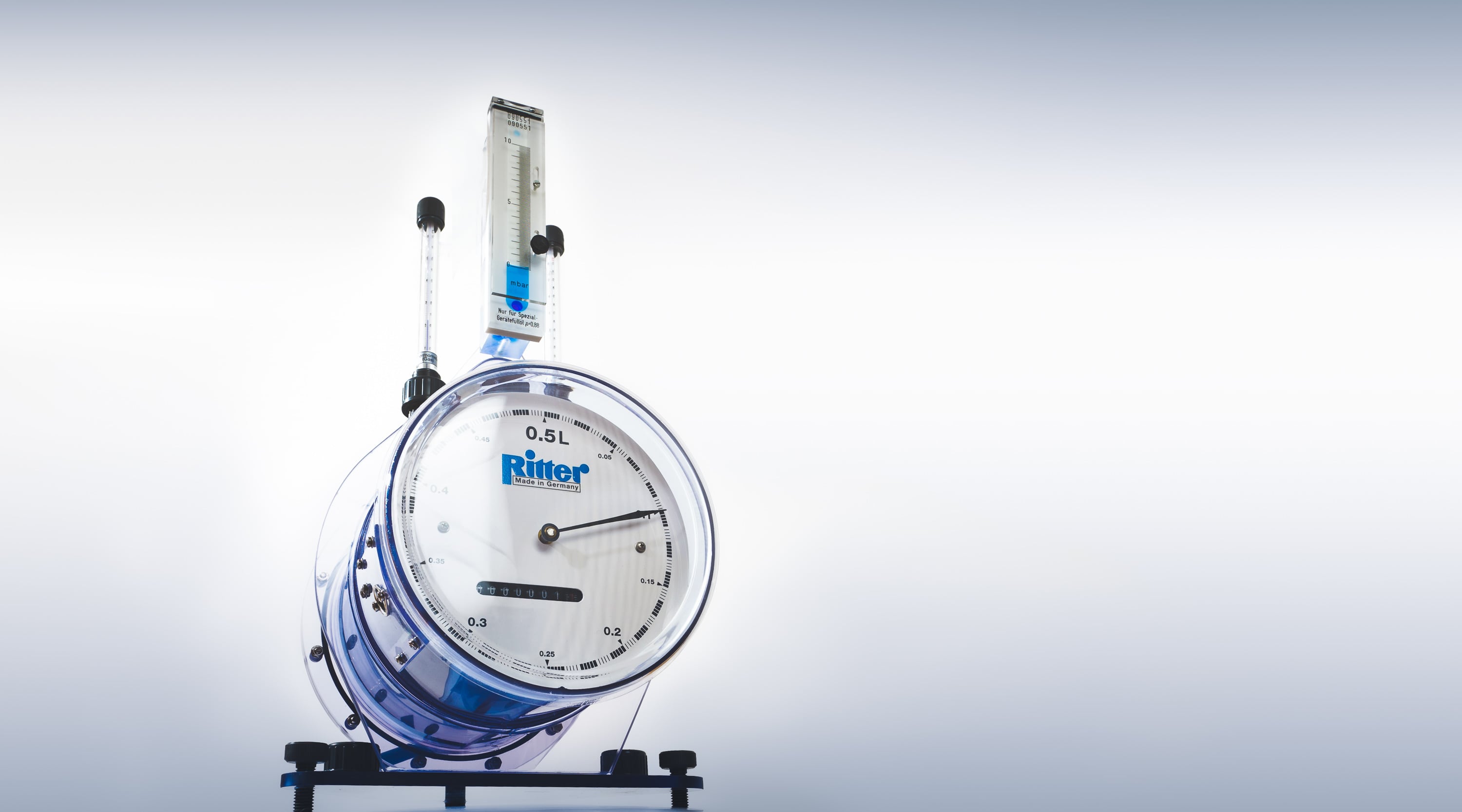RITTER Drum-type Gas Meters TG-Series (Wet-Test)
User Benefits
- Highest accuracy: ±0,5% across full flow rate range
- Calibration traceable to the German National Primary Standard (PTB)
- Measurement of all gases and gas mixtures with equal accuracy
- Use with extremely corrosive and inert gases
- Lowest measurable flow rates
- Largest selection of measuring ranges
- Real time data acquisition option for PC (requires option »Pulse Generator«)
- Most durable construction – available, both chemically (from high-quality thermoplastics) and mechanically (stainless steel)
- Maintenance-free (just checking of packing liquid level required)
Performance Specifications
| Type | Flow Rate Minimum (ltr/h) | Flow Rate Maximum (ltr/h) | Flow Rate Standard (ltr/h) (1) | Readout Indication Minimum (ltr) (2) | Readout Indication Maximum (ltr) | Measuring Drum Volume (ltr) | Pressure Loss Minimum (mbar) |
|---|---|---|---|---|---|---|---|
| TG 0.5 | 1 | 60 | 50 | 0.002 | 9,999,999.9 | 0.5 | 0.4 |
| TG 1 | 2 | 120 | 100 | 0.01 | 99,999,999 | 1.0 | 0.2 |
| TG 3 | 6 | 360 | 300 | 0.02 | 99,999,999 | 3.0 | 0.2 |
| TG 5 | 10 | 600 | 500 | 0.02 | 99,999,999 | 5.0 | 0.2 |
| TG 10 | 20 | 1,200 | 1,000 | 0.1 | 99,999,999 | 10.0 | 0.1 |
| TG 20 | 40 | 4,000 | 3,200 | 0.2 | 999,999,990 | 20.0 | 0.1 |
| TG 25 | 50 | 7,000 | 5,000 | 0.1 | 999,999,990 | 25.0 | 0.1 |
| TG 50 | 100 | 18,000 | 10,000 | 0.5 | 999,999,990 | 50.0 | 0.1 |
(2) Minimum dial division
The maximum gas inlet overpressure is dependent on the gas meter type and casing material:
With plastic casings TG05 – TG5: Standard version 50 mbar
With plastic casings TG10 – TG50: 50 mbar
With stainless steel casings: 0.5 to 40 bar
Measuring accuracy: ± 0.2% at standard flow rate (exact value is stated in individual Calibration Certificate) and approx. ± 0.5% across the entire measuring range.
Available Models (Materials)
| Material Number | Casing Material | Measuring Drum Material |
|---|---|---|
| 01 | Stainless steel | PVC-grey |
| 02 | Stainless steel | PE-el |
| 03 | Stainless steel | PP-grey |
| 04 | Stainless steel | PVDF |
| 05 | PVC-transparent | PVC-grey |
| 06 | PP-grey | PP-grey |
| 07 | PVDF | PVDF |
| 08 | PE-el | PE-el |
| Legend | ||
|---|---|---|
| PE-el | = | Polyethylene-electrically conductive |
| PP | = | Polypropylene |
| PVC | = | Polyvinyl chloride |
| PVDF | = | Polyvinylidene fluoride |
| Stainless steel | = | 1.4571 |
| Viton | = | Fluorine rubber |
For chemical resistance properties please contact your RITTER distribution partner.
Application
Advantages
Advantages of Drum-type Meters in General
The direct measurement of volume is the major advantage and the superiority of volumetric gas meters (like drum-type gas meters) over other measurement principles, which determine gas volume using secondary measurable variables such as speed, heat capacity, hot-wire resistance or similar. That means that the condition and the composition of the gas do not influence the measurement accuracy.Correcting factors which take into account gas type, temperature, humidity etc are therefore not necessary. It should be noted that with other, non-volumetric measurements the accuracy given for that measurement can only be achieved if the correcting factors for the actual gas condition or gas mixture are exactly known.
The drum-type meters need no maintenance and no power supply (unless equipped with option »Pulse Generator).Advantages of RITTER Drum-type Meters
- Casing and Measuring Drum out of superior plastics
RITTER Drum-type Gas Meters are specifically designed for use with corrosive gases. They are made out of a selection of 4 superior plastics (PVC, PP, PVDF and electrically-conductive PE). A gas meter can therefore be selected which is completely resistant to the corrosive gases being measured. Stainless steel is not completely resistant to corrosive gases and will be damaged by them over time.
Even RITTER’s Gas Meters with a stainless steel casing have a measuring drum made out of one of these high quality thermoplastics. This is because the measuring drum is the most important part of the gas meter and also the most susceptible to the effects of corrosive gases. - Measuring Drum is welded – not soft soldered
Competitor meters have a stainless steel casing and a measuring drum that is also made out of stainless steel. Because the steel plates used to make these measuring drums have to be so thin, they can only be soft soldered together. Soft solder weldings are eaten away by aggressive gases very easily! So even when the stainless steel itself is fairly resistant to corrosive gases, the soft soldering is not. This can cause the measuring drum to completely fall apart when the soft soldering is eaten away.
The measuring drum parts in RITTER Gas Meters are welded together with exactly the same material that the drum is made out of. PVC drums are welded together with PVC rods; PP drums with PP rods, PVDF drums with PVDF rods and PE drums with PE rods. The welds in RITTER Gas Meters are therefore as corrosion-resistant as the material used to build the drums. - Casing and Measuring Drum resistant against Packing Liquid – if turned into an acid
All drum-type gas meters contain a Packing Liquid – usually water. If the measuring drum is stainless steel and is used to measure a gas which reacts with water to form an acidic solution, the acidic solution can eat through the part of the measuring drum sitting under the water-line. This occurs most rapidly in gas meters which are not used very often. RITTER Gas Meters do not have this problem. - No epoxy coating needed for measuring drums
Some gas meter manufacturers offer stainless steel measuring drums with epoxy coating. It is very difficult to apply the coating completely evenly on the drum surface, especially in the sharp corners of the drum (where the soft solder welds are). These are weak spots where corrosive gases can even more easily start to attack and destroy the drum material and soft solder welds. - Magnetic Coupling instead of O-ring for drum axis
Measurement Principle
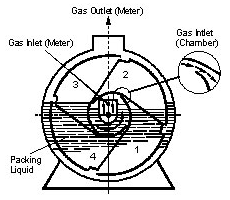
Phase 1
Chamber 1: Beginning of filling (into space above packing liquid)
Chamber 2: During filling
Chamber 3: Emptying
Chamber 4: Not active
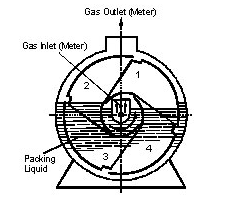
Phase 2
Chamber 1: During filling
Chamber 2: Emptying
Chamber 3: Not active
Chamber 4: Beginning of filling (into space above packing liquid)
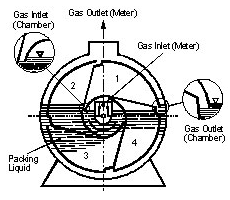
Phase 3
Chamber 1: Filling completed / Chamber inlet & outlet closed
Chamber 2: Emptying
Chamber 3: Not active
Chamber 4: Filling
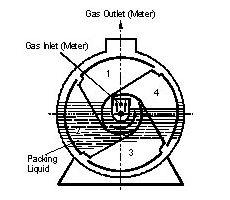
Phase 4
Chamber 1: Emptying
Chamber 2: Emptying
Chamber 3: Filling
Chamber 4: Just beginning to fill
Standard Equipment
- Multi-Chamber Measuring Drum
- Magnetic coupling between measuring drum and counter (for an absolutely liquid-tight casing)
- 8 or 9-digit Totalizing Roller Counter
- Large One-needle Dial
- Supports for Thermometer and Manometer
- Viton sealing
- Level and Levelling Feet
- Bubble level for levelling
Accessories
Built-in Options
- LCD Display, resettable, 8-digit (replaces Totalizing Roller Counter)
- Pulse Generator, standard or Ex-proof version (for connecting Electronic Display Unit/Computer)
- High Precision Packing Liquid Level Indicator »HPLI«, for packing liquid level
Accessories (external)
- Software »RIGAMO« RIGAMO
- Resistance Temperature Sensor (Gas), 100 mm
- Resistance Temperature Sensor (Packing Liquid), 200 mm
- Thermometer Gas (TG), measuring range 0 °C to +60 °C
- Thermometer Packing Liquid (TG), measuring range 0 °C to +60 °C
- Manometer for pressure pmax ≤ 50 mbar, measuring range 0-10 / 0-20 / 0-50 mbar
- Manometer for pressure pmax ≤ 1 bar, measuring range 0-600 mbar
- Manometer for pressure pmax ≤ 10 bar, measuring range 0-6 / 0-10 bar; available for higher pressure ranges
- Pressure Transmitter
- Electronic Display Unit »EDU 32 FP«, displays volume and calculates flow rate via RS232 and analog-output in realtime (pulse generator required)
Packing liquids
- Packing Liquid Pionier 4281 only for Drum-type Gas Meters (TG)
- Packing Liquid HCl solution 1.8 vol% for gas mixtures with CO2
(available quantities: 100 / 200 / 500 / 1,000 / 5,000 ml) - Packing Liquid Silox for gas mixtures without CO2
- Packing Liquid CalRiX only for Drum-type Gas Meters (TG)
Data-sheets
TG Plastic (≤500mbar)
TG Stainless steel (≤1bar)
TG Stainless steel (>1bar)
- TG 0.5 Stainless steel 6 bar
- TG 1 Stainless steel 6 bar
- TG 1 Stainless steel 10 bar
- TG 1 Stainless steel 16 bar
- TG 1 Stainless steel 40 bar
- TG 3 Stainless steel 6 bar
- TG 3 Stainless steel 10 bar
- TG 5 Stainless steel 6 bar
- TG 10 Stainless steel 6 bar
- TG 20 Stainless steel 6 bar
- TG 25 Stainless steel 6 bar
- TG 25 Stainless steel 10 bar
- TG 50 Stainless steel 6 bar


